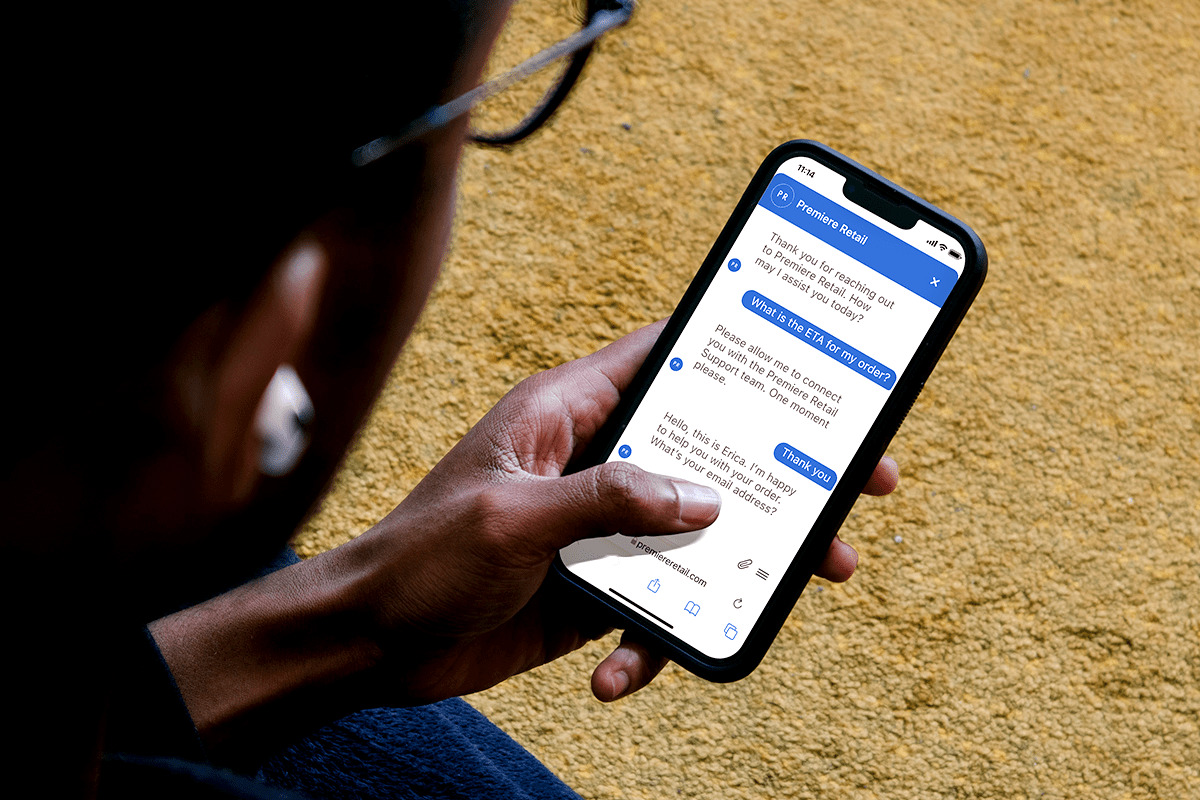We hate to break it to you, but the customer experience is getting worse.
Okay, maybe you already knew that.
With staffing shortages, supply chain disasters, inflation, and a looming recession, there’s a lot going on. And customer service seems to be bearing the brunt of it.
Forrester’s Consumer Index Ratings showed a big drop in the quality of customer experiences. CX fell for 19% of brands in 2022—the highest proportion of brands to drop in one year since the survey’s inception. Airlines and hotels are among the top industries seeing a drop, brought on by both internal and external factors.
While you can’t control the many economic factors contributing to this dip, there are some things you can control. Like your focus on customer service.
Avoid the pitfalls by fixing these top seven most common mistakes in customer service.
1. Making customers wait.
The mistake
Customers don’t like to wait. We repeat: Customers don’t like to wait. It’s an obvious point, yet in the past couple of years, customers have had to wait longer and longer for service.
There are some outside factors that have nothing to do with your business. The fast and thorough shift to online shopping left many businesses overwhelmed. Toward the beginning of the pandemic, almost 90% of customers experienced longer wait times than usual, according to CallMiner research.
And staffing shortages continue to be an issue, especially in positions that can struggle with keeping up morale. Even chattier callers (who’ve been devoid of human contact for much of the pandemic) have contributed to extended wait times.
But there are some things you could be doing to exacerbate customer wait times. Relying exclusively on one-to-one communication, like phone calls, can tie up agents’ time.
The fix
Turn to asynchronous communication channels, like text messaging, social media messaging, and in some cases web chat (also known as live chat). Asynchronous messaging doesn’t require both parties’ attention at the same time.
Pairing asynchronous channels with communication platforms, like Quiq, can make agents more efficient and cut down on your customer wait time. Agents can handle up to eight conversations at once—instead of being locked into a single phone call.
Embracing AI chatbots will also help reduce customer wait times by acting as your first line of defense. Chatbots help customer service teams move faster by fielding FAQs, collecting customer information, troubleshooting, and more.
2. Failing to create the right communications mix.
The mistake
There are two types of companies that make this mistake:
1. Company A: This is the “If it’s not broke, don’t fix it” company. They likely offer support through phone and email. Maybe they have a lightly-manned web chat feature on their site. The problem is, they don’t know that this way IS broken.
These companies are holdovers from a bygone era. They probably still think customer service is a drain on their company resources (instead of the moneymaker that it is).
Then there’s Company B…
2. Company B: They are excited and ready to hit the ground running. They’re on all the platforms, but they don’t have a strategy and they definitely don’t have a conversational platform.
While their enthusiasm counts for a lot, agents will be stretched too thin to serve customers everywhere at once. Being everywhere without a plan is just as likely to leave customers frustrated and unhappy.
Both companies are making the same big mistake: They’ve selected the right communications mix for their business, but not the right mix for their customers.
The fix
The fix for both companies is actually the same. Start with a strategy.
Meet the basics first. Give customers a way to instantly connect with your team. Ideally, that’s web chat (also called live chat), SMS text messaging, and voice.
Once you have their instant needs met, look to be available to customers on their terms. Do they hang out on Twitter? Instagram? Choose the platforms that make sense for your customer base. And don’t forget to add channels like Google Business Messaging and Apple Messages for Business to be easily accessible from your customers’ phones.
A key piece to making these multiple platforms work is having a conversational platform like Quiq. It can help agents manage multiple conversations across channels and ensure seamless customer experiences.
3. Using outdated methods of customer service.
The mistake
In the past, tiered customer service models reigned supreme. It treated customer service like a video game. Customers start at the first level, a typical IVR system or intake agent, and level up to the next “boss” until their problem got solved.
There’s a lot wrong with that model.
It perpetuates the “let me speak to your manager” attitude, making customers think they can get different answers than your agents are providing if they go one step up the leadership chain. Agents might not feel supported by their leaders, which could lead to low morale and faster burnout as a result. Methods like these are likely partially responsible for how customer service agents feel about their jobs. According to Zendesk’s CX Trends report, 38% say the service team is not treated as well as others in the organization.
It’s also not great for your customers. They’ll likely have to repeat themselves with each new person they speak with, which is a big pet peeve for many. In fact, 71% of global customers expect a company to share information so they don’t have to repeat themselves.
Plus, it simply takes longer to resolve. It prohibits you from giving customers the fast, frictionless experience they expect—and deserve.
The fix
Move to a collaboration model of customer service. Customer service tools like CRM software and conversational platforms make it easy for agents to work together to solve customer issues as they come up.
Managers, technicians, engineers, IT, or anyone on your team can pop into customer conversations to solve problems. They can read the conversation history, take a look at snippets, and review the sentiment analysis to see how the conversation is going and how they can help solve the problem. Customers are happy because they don’t have to repeat themselves, and agents don’t feel like they’re the blunt end of a battering ram.
4. Ignoring touchpoints in your customer service journey.
The mistake
Is your team especially helpful until the customer hands over their credit card? Good customer service doesn’t stop at the sale. It also doesn’t exist just to answer post-purchase questions. What makes good customer service great is the attention to the entire customer service journey.
54% of customers say that customer service feels like an afterthought, according to Zendesk.
The fix
When you’re small, it’s easy to just wing customer service. You’re so busy that you simply deal with problems as they come up. But once you’ve scaled your customer service team, it’s time for a thoughtful strategy.
Take a look at every customer touchpoint and see what you can do to improve the customer service experience. After your guests purchase an airline ticket, can you provide FAQs about their travel destination? Can you do more early in the buying process to help ease decision-making? What about questions that pop up on social media?
5. Not proactively engaging with customers.
The mistake
Businesses with high volumes of customer server inquiries are especially prone to making this mistake. Your agents are busy handling myriad customer requests, which run the gamut from simple FAQs to more complex problems. Every day is a mixed bag, and it’s hard to adequately prepare.
The bigger problems are the complaints not being addressed. What are your customers dealing with that you don’t hear about? How much of your customer churn is related to service and product issues that you never even hear about?
The fix
The best kind of customer service is the kind that solves problems before they happen. Make note of the top FAQs and see what you can do to help customers find these answers without having to reach out. Some common questions, like “Where’s my order?” can be solved by sending outbound messages with tracking links and order updates. Minimize sizing questions by proactively offering sizing consultations. Share video tutorials. Getting ahead of these questions can free up your team for more complex problems.
6. Expecting agents to learn on the fly.
The mistake
You have a CRM. You have your product guide books/service manuals/insert whatever written learning materials you have—that should be enough to get new agents started, right? Not quite.
Only 20% of customer service agents are extremely satisfied with their training, according to Zendesk. But they’re not the only ones that notice it. Your customers do, too, with 68% saying it feels like most businesses need to improve their customer service agents’ training.
The fix
At the very least, ensure your agents have access to product and customer information at their fingertips. Your CRM software and product databases should be integrated into your conversation platform. Your agents should be able to access information easily and quickly to give your customers that seamless experience they crave.
But just because your agents don’t need to memorize as much product information as they used to doesn’t mean you can skimp on training. Shift training to focus on soft skills, like effective communication, conflict resolution, and creative problem-solving.
7. Not actively listening to your customers.
The mistake
Customer service often feels like “the complaint department.” When your customer service team deals with frequent complaints, there’s a risk of apathy. Agents can get overwhelmed and stop caring about customer issues. It’s too easy to deal with immediate problems without looking for long-term solutions.
The mistake isn’t just about not listening to your customers. It’s also about showing that you’re listening to your customers. You may have closed-door conversations about how to improve products and services—but if customers don’t hear it or see it, did it really happen?
The fix
This mistake takes a multi-pronged approach, depending on which feedback facet you’re facing.
When customers don’t feel valued when chatting with agents: It’s time for some empathy training. Sometimes it’s not enough to solve customers’ problems, they want to be heard and understood. Offer empathy training to your agents as part of the onboarding process, and offer refresher courses a couple of times a year. Your agents likely face the same outside stressors that your customers do, so help them manage stress during difficult times.
When customers feel like their feedback goes right into the trash bin: When customers voice larger complaints, the last thing they want to hear is a trite “Thank you, we’ll elevate this issue to the appropriate channels.” They want to know their complaint or suggestion was heard by the right people—and that someone is doing something about it. Create a systemized way to collect feedback and put it into action, then share your system.
When you’re only hearing crickets: No complaints. Great, right?! Maybe. Maybe you aren’t giving your customers the space to do so. Be sure to solicit customer feedback through frequent customer satisfaction surveys. Customers will have a place to be heard, and you’ll have valuable information to improve your products and services.
Refocus on your customer service.
When so many things are out of your control, the best thing to do is refocus on your customers. Avoiding these common mistakes in customer service will help you provide a frictionless experience that keeps them coming back for more.



